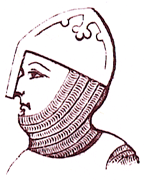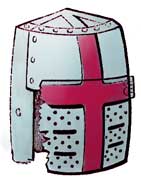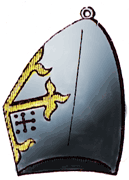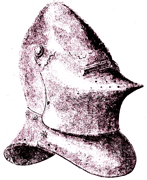Medieval Helmets
Norman helmet
From the Norman Conquest to the end of the 12th century, the Medieval Helmets were mainly of the type known as the "nasal helmet", a casque with an extension protecting the nose, hence the name. It was also known as the "Casque Normand", and it was surmounting the continuous coif.
The characteristic Norman Helmet is conical, usually made of four triangular pieces of metal plate riveted in a ring and meeting at the apex. The nasal was broad enough to conceal the face to such an extent that sometimes the knight had to take his helmet off in order to be recognized.

Norman (Nasal) Helmet
As a main piece of defense, the continuous coif, named this way because it was continuing the hauberk, is seen constantly in the Bayeux tapestry. It is shown also in many seals of the 12th century, and in vellum paintings of this time. The hood of mail will eventually be separated from the hauberk in the 13th century.
The helmets without nasals were chiefly conical, round and flat-topped.
Medieval cylindrical helmet
Among the most characteristic helmets of the Middle Ages was the cylindrical or flat-topped helmet, which came into fashion towards the end of the 12th century. In the 13h century it became very common. In its earliest examples, the casque was of one piece, having two horizontal clefts for vision, and being strengthened by bands crossing each other over the face and on the top.The term cylindrical must not always be understood literally. In some cases, the cylinder swells, taking the barrel form. The helmet had a grated-ventail by which a better supply of air could always be obtained. A still more abundant provision occasionally was acquired by opening the ventaglia, constructed with hinges at the sides.
At the beginning of the 13th century, the continuous coif is still part of the hauberk of chain-mail. The shape was flattened at the top of the head. In the second half of the century, the round topped coif was more usual.

Medieval Helm With Movable Ventail
Medieval helmets classification
An important change in Medieval armor construction is marked by the development of the great Medieval helm, the casque enclosing the whole head of the knight. The great casque came into use towards the end of the 12th century. From now on, the Middle Ages helmets can be classified in two categories: helms and helmets. The term helm will be used to designate the new type of headpiece, while the helmet will designate a piece of diminished completeness, the non-closed casque.
There were two leading kinds of this head armor: the helm was either one piece, or the front was provided with a moveable ventail. The flat-topped helm with movable ventail appears about the middle of the century. The successive changes of fashion supply a further division of the helms: the flat topped, the round topped, and the sugar-leaf form. Around 1270, the round-topped helm came into vogue. The helm was worn over the coif of chain-mail.
The helmets may be classed as the hemispherical, the cylindrical, the conical, and the nasal. The bascinet was in use at this time, but do not appear to have been anything more than the round-topped skull-cap.

Medieval Sugar Loaf Helm
In the 14th century, the head protection may be considered under the same two classes of helms and helmets. Helms provided freedom of breathing by means of perforations in the lower part. Some had holes made on the right side, in order that the lance of the antagonist, who, if in a tilt passed on that side, might glide off freely. Helms were made mainly of iron or steel, and were occasionally guilt. For war, the great helm was placed over the bascinet.
Most fashionable Medieval helmet: Bascinet
The Middle Ages helmets became more sophisticated , and the movable visor was introduced. The helmets of the 14th century are composed chiefly of a mixture of iron plate and chain mail. Among them, the visored bascinet with camail was much in vogue. It was made of three parts: the skull-piece, the visor, and the camail.
The visor, which turned on side pivots, could be removed, so it allows the helm to be added to the knight defenses by placing it over the bascinet. However, this was not a rule, as the visored bascinet itself was sometimes used for war, instead of the helm. It is in this century that the beaked bascinet was also introduced. The bascinet did not necessarily exhibit the plain surface of steal, and was often covered with leather. The rich knights and Kings could wear helmets with decorations ranging from velvet to gold and precious stones.

Visored Bascinet
Medieval helmets in the 15th century
The Medieval helmets of this period exhibit crests of every variety of fanciful design. Thought a particular crest was no doubt generally worn by each knight, it was not unusual for a champion to appear with the crest of some remote ancestor. Sometimes, no more than a plume of feathers was worn in lieu of any definite cognizance.
The beaked bascinet was widely used, as illustrated in the illuminations of the beginning of the century, and the Medieval helmets were further diversified with the introduction of the bascinet with globose (rounded) visor.
